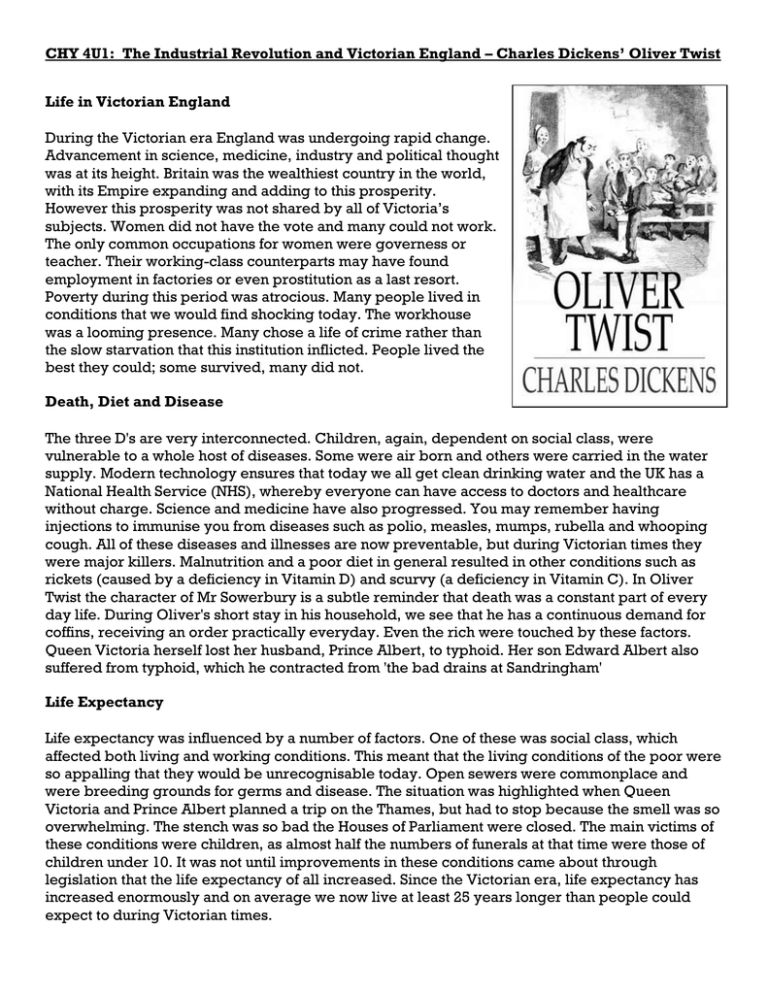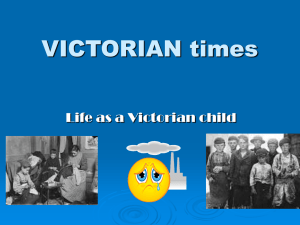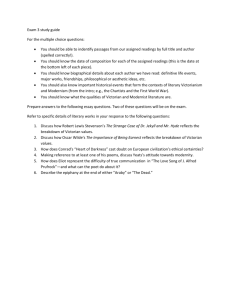CHY 4U1: The Industrial Revolution and Victorian England –... Life in Victorian England
advertisement

CHY 4U1: The Industrial Revolution and Victorian England – Charles Dickens’ Oliver Twist Life in Victorian England During the Victorian era England was undergoing rapid change. Advancement in science, medicine, industry and political thought was at its height. Britain was the wealthiest country in the world, with its Empire expanding and adding to this prosperity. However this prosperity was not shared by all of Victoria’s subjects. Women did not have the vote and many could not work. The only common occupations for women were governess or teacher. Their working-class counterparts may have found employment in factories or even prostitution as a last resort. Poverty during this period was atrocious. Many people lived in conditions that we would find shocking today. The workhouse was a looming presence. Many chose a life of crime rather than the slow starvation that this institution inflicted. People lived the best they could; some survived, many did not. Death, Diet and Disease The three D's are very interconnected. Children, again, dependent on social class, were vulnerable to a whole host of diseases. Some were air born and others were carried in the water supply. Modern technology ensures that today we all get clean drinking water and the UK has a National Health Service (NHS), whereby everyone can have access to doctors and healthcare without charge. Science and medicine have also progressed. You may remember having injections to immunise you from diseases such as polio, measles, mumps, rubella and whooping cough. All of these diseases and illnesses are now preventable, but during Victorian times they were major killers. Malnutrition and a poor diet in general resulted in other conditions such as rickets (caused by a deficiency in Vitamin D) and scurvy (a deficiency in Vitamin C). In Oliver Twist the character of Mr Sowerbury is a subtle reminder that death was a constant part of every day life. During Oliver's short stay in his household, we see that he has a continuous demand for coffins, receiving an order practically everyday. Even the rich were touched by these factors. Queen Victoria herself lost her husband, Prince Albert, to typhoid. Her son Edward Albert also suffered from typhoid, which he contracted from 'the bad drains at Sandringham' Life Expectancy Life expectancy was influenced by a number of factors. One of these was social class, which affected both living and working conditions. This meant that the living conditions of the poor were so appalling that they would be unrecognisable today. Open sewers were commonplace and were breeding grounds for germs and disease. The situation was highlighted when Queen Victoria and Prince Albert planned a trip on the Thames, but had to stop because the smell was so overwhelming. The stench was so bad the Houses of Parliament were closed. The main victims of these conditions were children, as almost half the numbers of funerals at that time were those of children under 10. It was not until improvements in these conditions came about through legislation that the life expectancy of all increased. Since the Victorian era, life expectancy has increased enormously and on average we now live at least 25 years longer than people could expect to during Victorian times. The Workhouses In the workhouse the boys would have been fed on watery gruel and would have slept on the floor with nothing but sacks for covering, and a constant cold chill from both the wind and the dreary, terrifying atmosphere of the building. The workhouse was a very "Christian" institution concerned with the souls of its inmates. To that end there would be plaques carrying religious messages "God is just", "God is good". The Guardians of the workhouse believed that they were improving the inmates’ morality as well as saving them from decline. Families were not allowed to stay together. One man demanded the 'release' of his wife and children. He was then told 'you may take your children, but we buried your wife three weeks ago'. The workhouses had a very strong work ethic. In Oliver Twist we see a typical form of work, that of picking oakum. Other forms included bone crushing and corn grinding. The combination of this severe workload and poor diet resulted in many inmates dying within the walls of the workhouse. Street Life The squalor of the London streets was a fascination for Dickens and is dominant in many of his novels. The abject poverty juxtaposed against the wealth and beauty of the metropolis is quite astonishing. The streets were always full of life, full of people from pickpockets to elegant ladies out shopping. The poverty in certain areas left people starving, children dying of disease and prostitutes working in filthy conditions. It was a rich city full of layers; various classes and both genders were thrown into the midst of the capital together, some ignored those beneath them, some helped them make a better life. "A dirtier or more wretched place he had never seen. The street was very narrow and muddy and the air was impregnated with filthy odours. There were a good many small shops; but the only stock in trade appeared to be heaps of children, who, even at that time of night, were crawling in and out at the doors, or screaming from the inside. The sole places that seemed to prosper, amid the general blight of the place were the public houses." Comprehension Questions After watching the movie Oliver Twist, read the article and answer the following questions: 1) What was wrong with the working conditions for children during the Victorian times? 2) Why didn't children refuse to work? 3) What kind of jobs did children do? 4) Why were children employed to work in factories?







